Aviation Safety, Security, and Emergency Planning: Regulations Review
VerifiedAdded on 2023/01/03
|42
|11725
|3
Report
AI Summary
This report provides a comprehensive overview of aviation safety, security, and emergency planning. It delves into the regulatory frameworks established by organizations like ICAO, focusing on Annex 19 (safety management), Annex 17 (security), and Annex 13 (accident investigation). The report examines the roles of various conventions such as Tokyo, Hague and Montreal in enhancing aviation security and the importance of human factors in aviation safety, including accident causation models like the Swiss cheese and SHELL models. It also explores the use of Safety Management Systems (SMS) and offers an opinion on the effectiveness of these regulations. The report further includes a discussion of the different types of devices and procedures used for screening, providing a complete analysis of the subject matter.
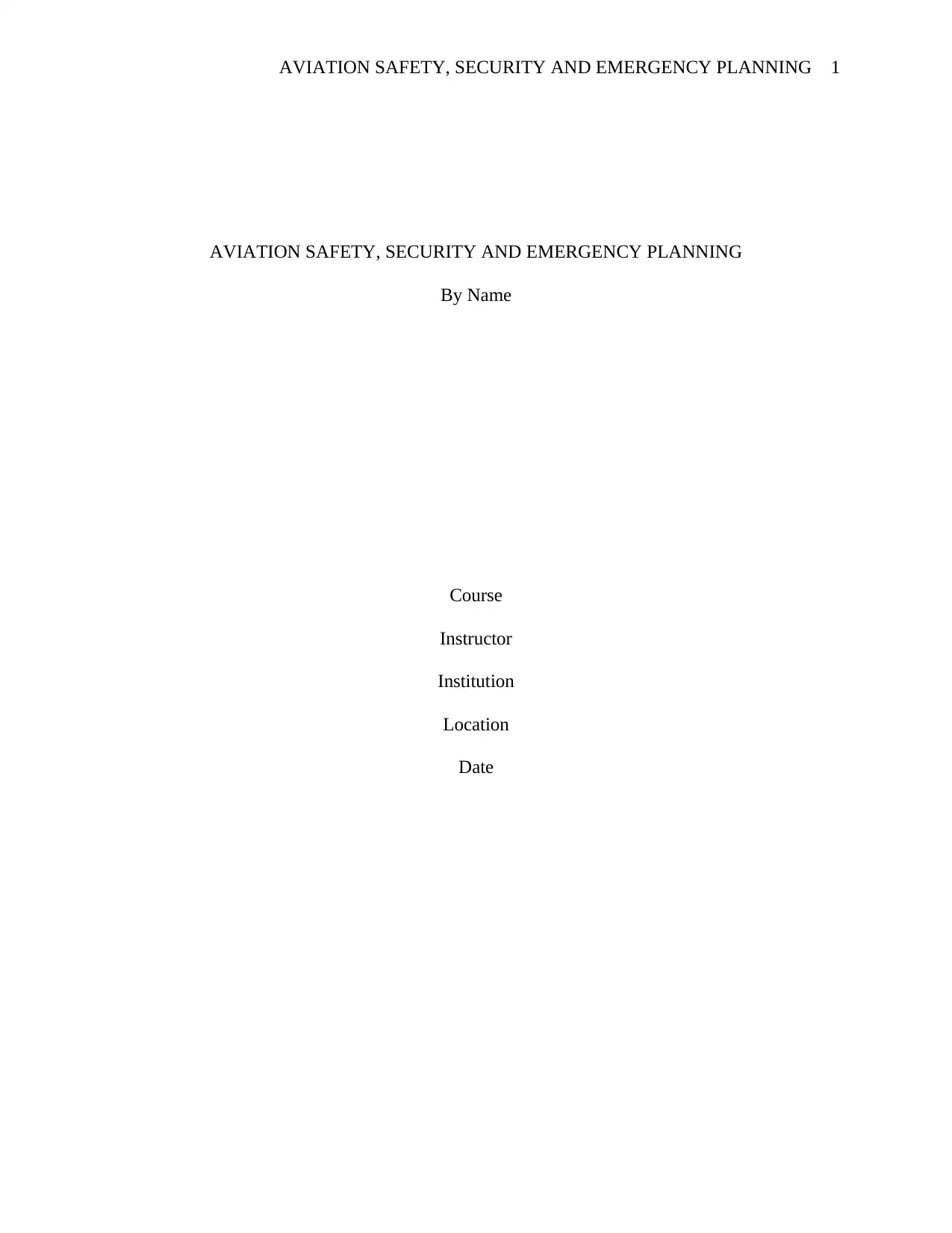
AVIATION SAFETY, SECURITY AND EMERGENCY PLANNING 1
AVIATION SAFETY, SECURITY AND EMERGENCY PLANNING
By Name
Course
Instructor
Institution
Location
Date
AVIATION SAFETY, SECURITY AND EMERGENCY PLANNING
By Name
Course
Instructor
Institution
Location
Date
Paraphrase This Document
Need a fresh take? Get an instant paraphrase of this document with our AI Paraphraser
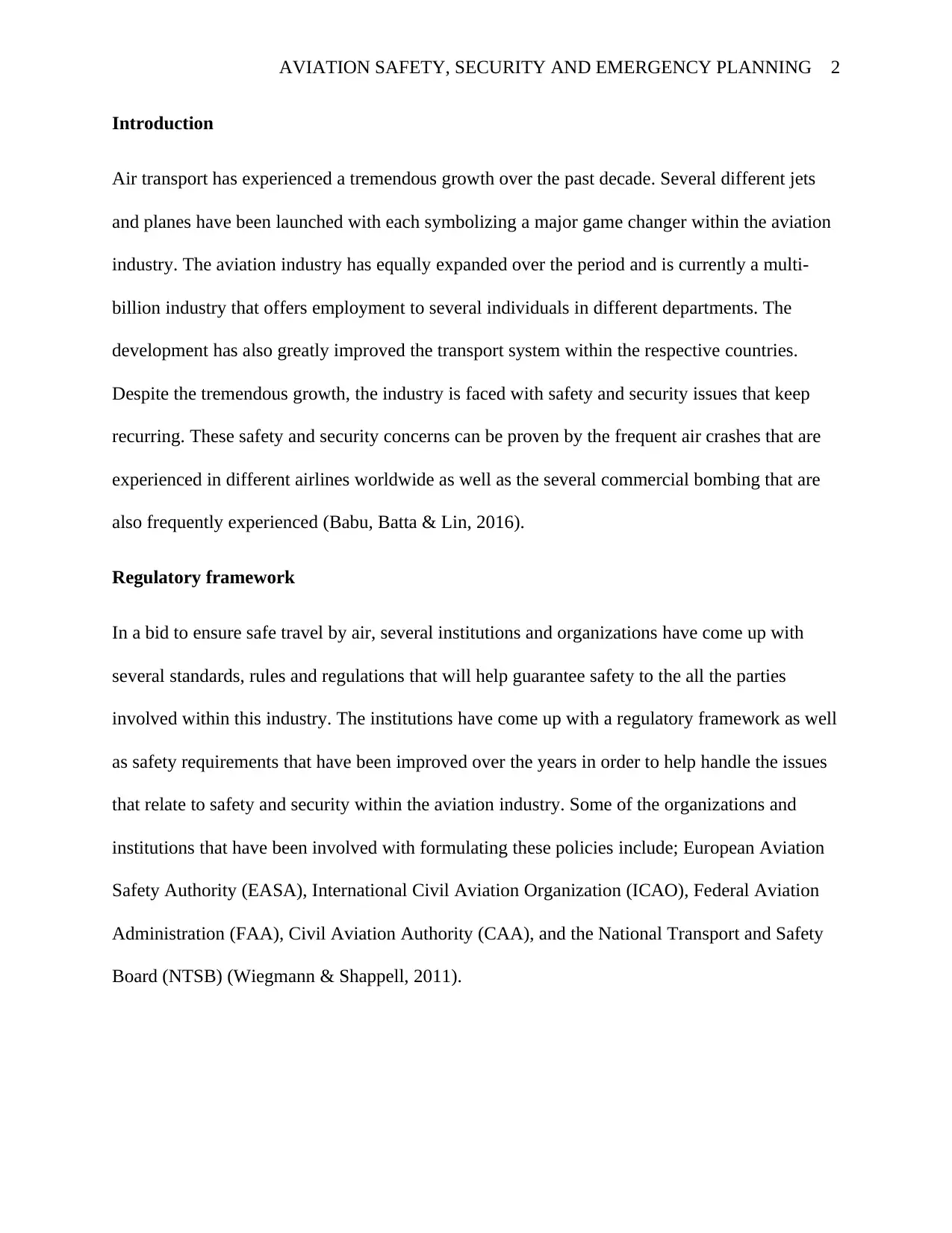
AVIATION SAFETY, SECURITY AND EMERGENCY PLANNING 2
Introduction
Air transport has experienced a tremendous growth over the past decade. Several different jets
and planes have been launched with each symbolizing a major game changer within the aviation
industry. The aviation industry has equally expanded over the period and is currently a multi-
billion industry that offers employment to several individuals in different departments. The
development has also greatly improved the transport system within the respective countries.
Despite the tremendous growth, the industry is faced with safety and security issues that keep
recurring. These safety and security concerns can be proven by the frequent air crashes that are
experienced in different airlines worldwide as well as the several commercial bombing that are
also frequently experienced (Babu, Batta & Lin, 2016).
Regulatory framework
In a bid to ensure safe travel by air, several institutions and organizations have come up with
several standards, rules and regulations that will help guarantee safety to the all the parties
involved within this industry. The institutions have come up with a regulatory framework as well
as safety requirements that have been improved over the years in order to help handle the issues
that relate to safety and security within the aviation industry. Some of the organizations and
institutions that have been involved with formulating these policies include; European Aviation
Safety Authority (EASA), International Civil Aviation Organization (ICAO), Federal Aviation
Administration (FAA), Civil Aviation Authority (CAA), and the National Transport and Safety
Board (NTSB) (Wiegmann & Shappell, 2011).
Introduction
Air transport has experienced a tremendous growth over the past decade. Several different jets
and planes have been launched with each symbolizing a major game changer within the aviation
industry. The aviation industry has equally expanded over the period and is currently a multi-
billion industry that offers employment to several individuals in different departments. The
development has also greatly improved the transport system within the respective countries.
Despite the tremendous growth, the industry is faced with safety and security issues that keep
recurring. These safety and security concerns can be proven by the frequent air crashes that are
experienced in different airlines worldwide as well as the several commercial bombing that are
also frequently experienced (Babu, Batta & Lin, 2016).
Regulatory framework
In a bid to ensure safe travel by air, several institutions and organizations have come up with
several standards, rules and regulations that will help guarantee safety to the all the parties
involved within this industry. The institutions have come up with a regulatory framework as well
as safety requirements that have been improved over the years in order to help handle the issues
that relate to safety and security within the aviation industry. Some of the organizations and
institutions that have been involved with formulating these policies include; European Aviation
Safety Authority (EASA), International Civil Aviation Organization (ICAO), Federal Aviation
Administration (FAA), Civil Aviation Authority (CAA), and the National Transport and Safety
Board (NTSB) (Wiegmann & Shappell, 2011).
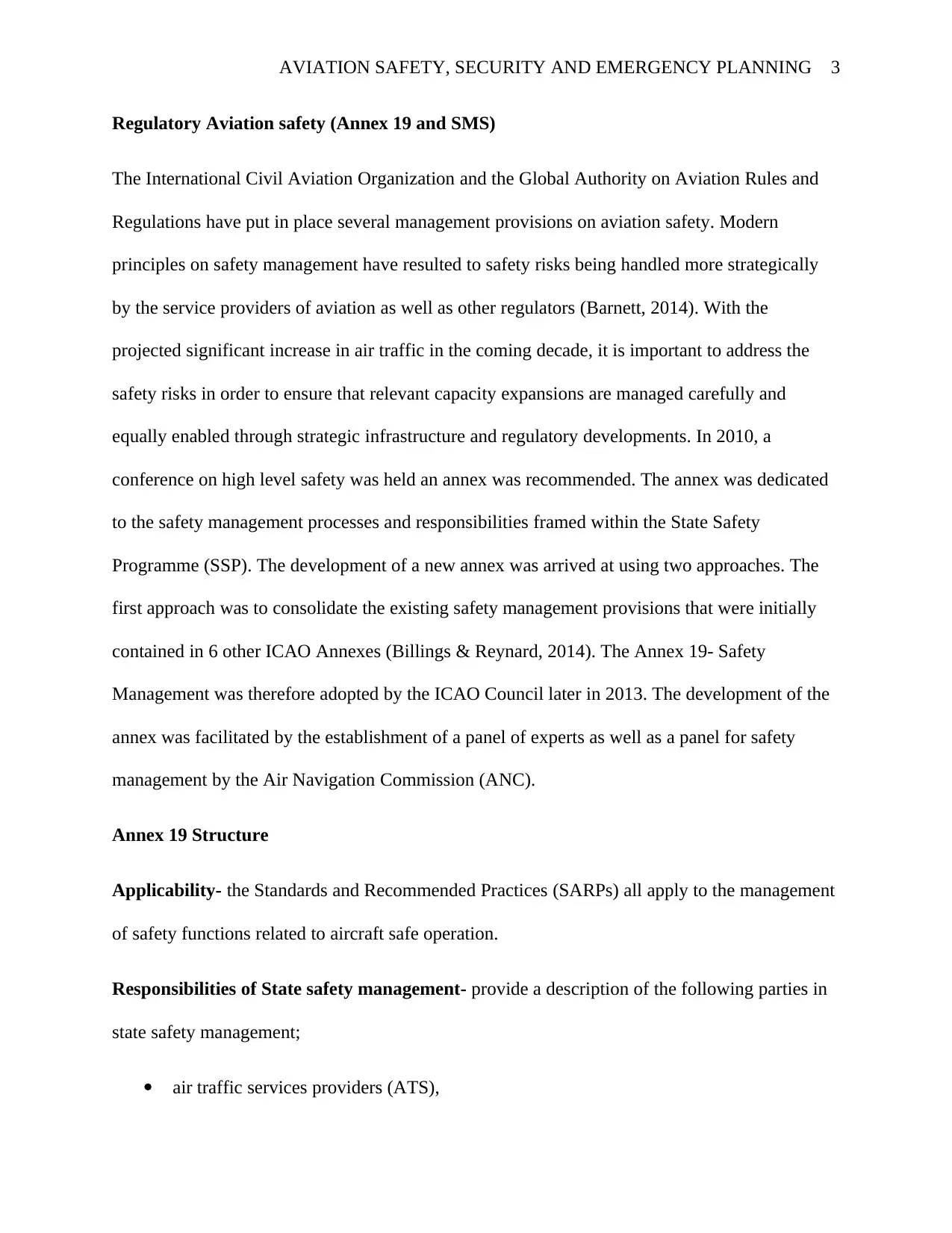
AVIATION SAFETY, SECURITY AND EMERGENCY PLANNING 3
Regulatory Aviation safety (Annex 19 and SMS)
The International Civil Aviation Organization and the Global Authority on Aviation Rules and
Regulations have put in place several management provisions on aviation safety. Modern
principles on safety management have resulted to safety risks being handled more strategically
by the service providers of aviation as well as other regulators (Barnett, 2014). With the
projected significant increase in air traffic in the coming decade, it is important to address the
safety risks in order to ensure that relevant capacity expansions are managed carefully and
equally enabled through strategic infrastructure and regulatory developments. In 2010, a
conference on high level safety was held an annex was recommended. The annex was dedicated
to the safety management processes and responsibilities framed within the State Safety
Programme (SSP). The development of a new annex was arrived at using two approaches. The
first approach was to consolidate the existing safety management provisions that were initially
contained in 6 other ICAO Annexes (Billings & Reynard, 2014). The Annex 19- Safety
Management was therefore adopted by the ICAO Council later in 2013. The development of the
annex was facilitated by the establishment of a panel of experts as well as a panel for safety
management by the Air Navigation Commission (ANC).
Annex 19 Structure
Applicability- the Standards and Recommended Practices (SARPs) all apply to the management
of safety functions related to aircraft safe operation.
Responsibilities of State safety management- provide a description of the following parties in
state safety management;
air traffic services providers (ATS),
Regulatory Aviation safety (Annex 19 and SMS)
The International Civil Aviation Organization and the Global Authority on Aviation Rules and
Regulations have put in place several management provisions on aviation safety. Modern
principles on safety management have resulted to safety risks being handled more strategically
by the service providers of aviation as well as other regulators (Barnett, 2014). With the
projected significant increase in air traffic in the coming decade, it is important to address the
safety risks in order to ensure that relevant capacity expansions are managed carefully and
equally enabled through strategic infrastructure and regulatory developments. In 2010, a
conference on high level safety was held an annex was recommended. The annex was dedicated
to the safety management processes and responsibilities framed within the State Safety
Programme (SSP). The development of a new annex was arrived at using two approaches. The
first approach was to consolidate the existing safety management provisions that were initially
contained in 6 other ICAO Annexes (Billings & Reynard, 2014). The Annex 19- Safety
Management was therefore adopted by the ICAO Council later in 2013. The development of the
annex was facilitated by the establishment of a panel of experts as well as a panel for safety
management by the Air Navigation Commission (ANC).
Annex 19 Structure
Applicability- the Standards and Recommended Practices (SARPs) all apply to the management
of safety functions related to aircraft safe operation.
Responsibilities of State safety management- provide a description of the following parties in
state safety management;
air traffic services providers (ATS),
⊘ This is a preview!⊘
Do you want full access?
Subscribe today to unlock all pages.

Trusted by 1+ million students worldwide
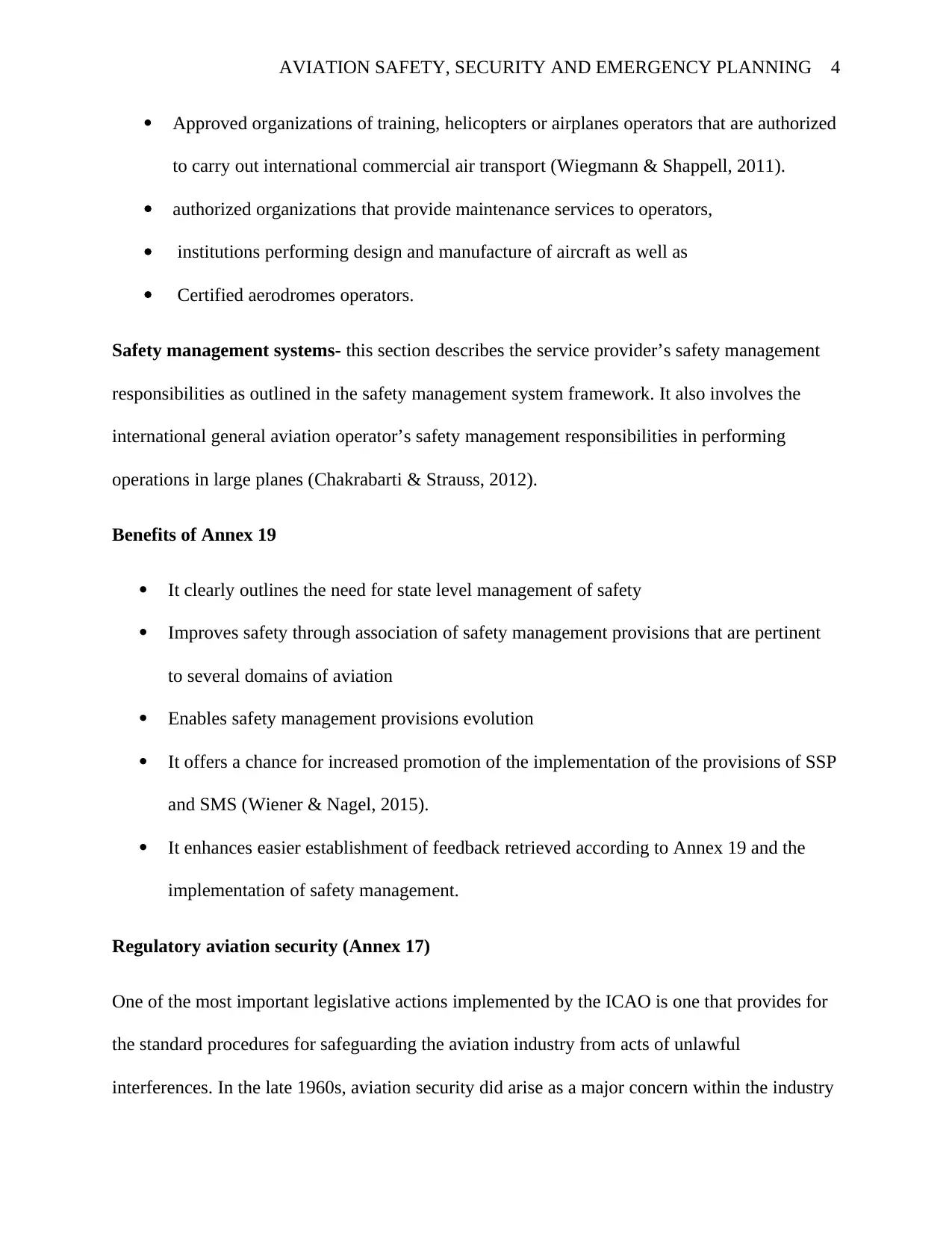
AVIATION SAFETY, SECURITY AND EMERGENCY PLANNING 4
Approved organizations of training, helicopters or airplanes operators that are authorized
to carry out international commercial air transport (Wiegmann & Shappell, 2011).
authorized organizations that provide maintenance services to operators,
institutions performing design and manufacture of aircraft as well as
Certified aerodromes operators.
Safety management systems- this section describes the service provider’s safety management
responsibilities as outlined in the safety management system framework. It also involves the
international general aviation operator’s safety management responsibilities in performing
operations in large planes (Chakrabarti & Strauss, 2012).
Benefits of Annex 19
It clearly outlines the need for state level management of safety
Improves safety through association of safety management provisions that are pertinent
to several domains of aviation
Enables safety management provisions evolution
It offers a chance for increased promotion of the implementation of the provisions of SSP
and SMS (Wiener & Nagel, 2015).
It enhances easier establishment of feedback retrieved according to Annex 19 and the
implementation of safety management.
Regulatory aviation security (Annex 17)
One of the most important legislative actions implemented by the ICAO is one that provides for
the standard procedures for safeguarding the aviation industry from acts of unlawful
interferences. In the late 1960s, aviation security did arise as a major concern within the industry
Approved organizations of training, helicopters or airplanes operators that are authorized
to carry out international commercial air transport (Wiegmann & Shappell, 2011).
authorized organizations that provide maintenance services to operators,
institutions performing design and manufacture of aircraft as well as
Certified aerodromes operators.
Safety management systems- this section describes the service provider’s safety management
responsibilities as outlined in the safety management system framework. It also involves the
international general aviation operator’s safety management responsibilities in performing
operations in large planes (Chakrabarti & Strauss, 2012).
Benefits of Annex 19
It clearly outlines the need for state level management of safety
Improves safety through association of safety management provisions that are pertinent
to several domains of aviation
Enables safety management provisions evolution
It offers a chance for increased promotion of the implementation of the provisions of SSP
and SMS (Wiener & Nagel, 2015).
It enhances easier establishment of feedback retrieved according to Annex 19 and the
implementation of safety management.
Regulatory aviation security (Annex 17)
One of the most important legislative actions implemented by the ICAO is one that provides for
the standard procedures for safeguarding the aviation industry from acts of unlawful
interferences. In the late 1960s, aviation security did arise as a major concern within the industry
Paraphrase This Document
Need a fresh take? Get an instant paraphrase of this document with our AI Paraphraser
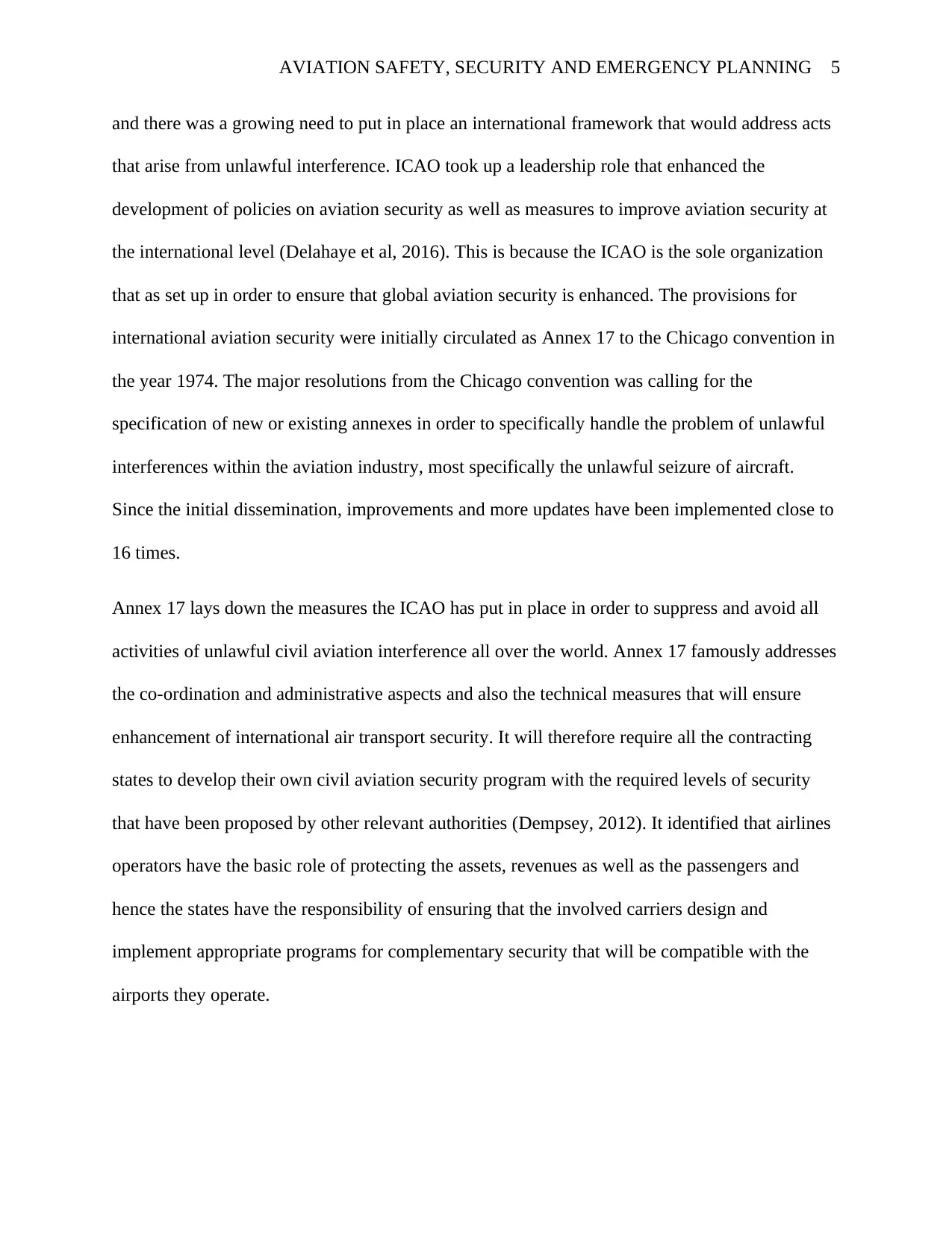
AVIATION SAFETY, SECURITY AND EMERGENCY PLANNING 5
and there was a growing need to put in place an international framework that would address acts
that arise from unlawful interference. ICAO took up a leadership role that enhanced the
development of policies on aviation security as well as measures to improve aviation security at
the international level (Delahaye et al, 2016). This is because the ICAO is the sole organization
that as set up in order to ensure that global aviation security is enhanced. The provisions for
international aviation security were initially circulated as Annex 17 to the Chicago convention in
the year 1974. The major resolutions from the Chicago convention was calling for the
specification of new or existing annexes in order to specifically handle the problem of unlawful
interferences within the aviation industry, most specifically the unlawful seizure of aircraft.
Since the initial dissemination, improvements and more updates have been implemented close to
16 times.
Annex 17 lays down the measures the ICAO has put in place in order to suppress and avoid all
activities of unlawful civil aviation interference all over the world. Annex 17 famously addresses
the co-ordination and administrative aspects and also the technical measures that will ensure
enhancement of international air transport security. It will therefore require all the contracting
states to develop their own civil aviation security program with the required levels of security
that have been proposed by other relevant authorities (Dempsey, 2012). It identified that airlines
operators have the basic role of protecting the assets, revenues as well as the passengers and
hence the states have the responsibility of ensuring that the involved carriers design and
implement appropriate programs for complementary security that will be compatible with the
airports they operate.
and there was a growing need to put in place an international framework that would address acts
that arise from unlawful interference. ICAO took up a leadership role that enhanced the
development of policies on aviation security as well as measures to improve aviation security at
the international level (Delahaye et al, 2016). This is because the ICAO is the sole organization
that as set up in order to ensure that global aviation security is enhanced. The provisions for
international aviation security were initially circulated as Annex 17 to the Chicago convention in
the year 1974. The major resolutions from the Chicago convention was calling for the
specification of new or existing annexes in order to specifically handle the problem of unlawful
interferences within the aviation industry, most specifically the unlawful seizure of aircraft.
Since the initial dissemination, improvements and more updates have been implemented close to
16 times.
Annex 17 lays down the measures the ICAO has put in place in order to suppress and avoid all
activities of unlawful civil aviation interference all over the world. Annex 17 famously addresses
the co-ordination and administrative aspects and also the technical measures that will ensure
enhancement of international air transport security. It will therefore require all the contracting
states to develop their own civil aviation security program with the required levels of security
that have been proposed by other relevant authorities (Dempsey, 2012). It identified that airlines
operators have the basic role of protecting the assets, revenues as well as the passengers and
hence the states have the responsibility of ensuring that the involved carriers design and
implement appropriate programs for complementary security that will be compatible with the
airports they operate.
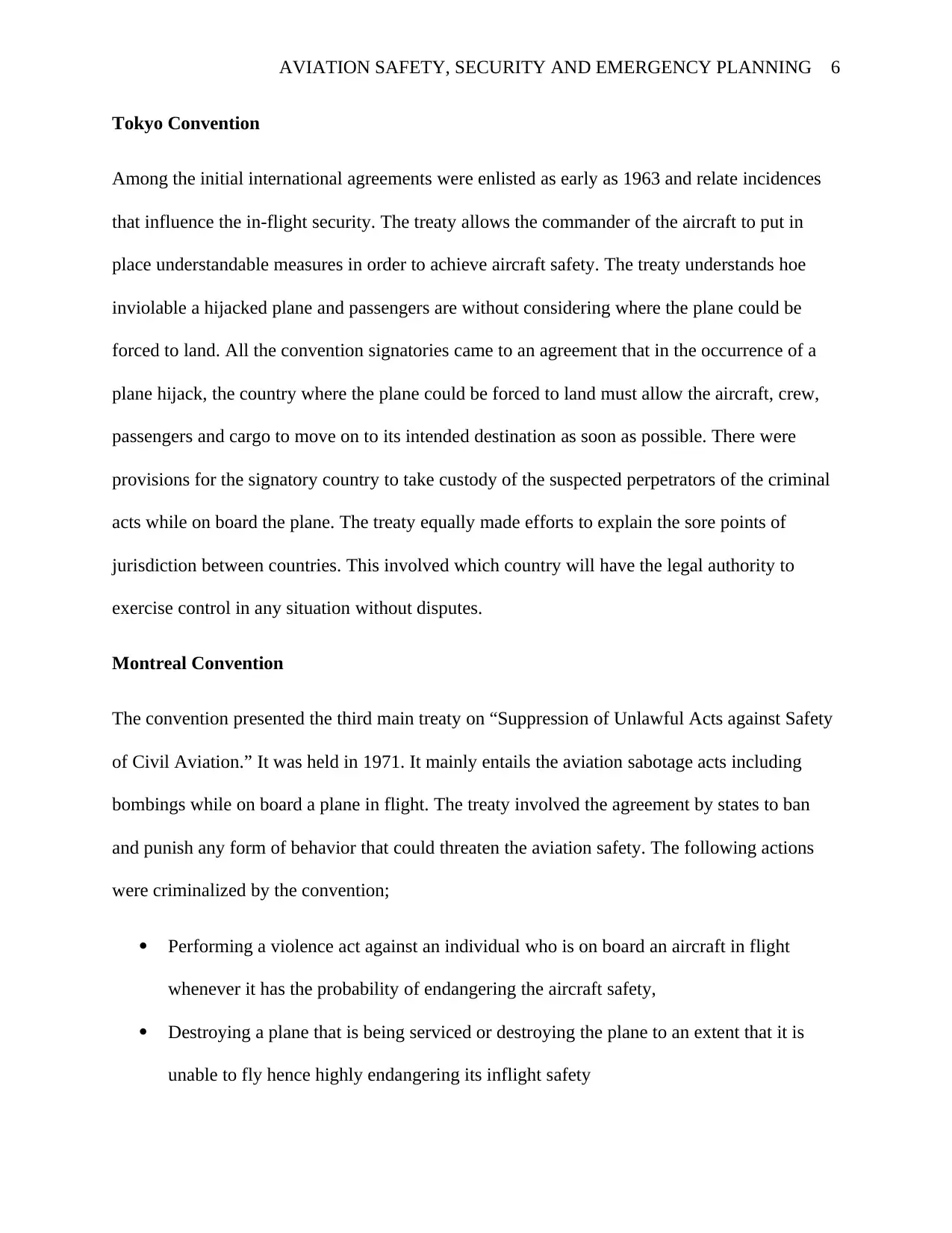
AVIATION SAFETY, SECURITY AND EMERGENCY PLANNING 6
Tokyo Convention
Among the initial international agreements were enlisted as early as 1963 and relate incidences
that influence the in-flight security. The treaty allows the commander of the aircraft to put in
place understandable measures in order to achieve aircraft safety. The treaty understands hoe
inviolable a hijacked plane and passengers are without considering where the plane could be
forced to land. All the convention signatories came to an agreement that in the occurrence of a
plane hijack, the country where the plane could be forced to land must allow the aircraft, crew,
passengers and cargo to move on to its intended destination as soon as possible. There were
provisions for the signatory country to take custody of the suspected perpetrators of the criminal
acts while on board the plane. The treaty equally made efforts to explain the sore points of
jurisdiction between countries. This involved which country will have the legal authority to
exercise control in any situation without disputes.
Montreal Convention
The convention presented the third main treaty on “Suppression of Unlawful Acts against Safety
of Civil Aviation.” It was held in 1971. It mainly entails the aviation sabotage acts including
bombings while on board a plane in flight. The treaty involved the agreement by states to ban
and punish any form of behavior that could threaten the aviation safety. The following actions
were criminalized by the convention;
Performing a violence act against an individual who is on board an aircraft in flight
whenever it has the probability of endangering the aircraft safety,
Destroying a plane that is being serviced or destroying the plane to an extent that it is
unable to fly hence highly endangering its inflight safety
Tokyo Convention
Among the initial international agreements were enlisted as early as 1963 and relate incidences
that influence the in-flight security. The treaty allows the commander of the aircraft to put in
place understandable measures in order to achieve aircraft safety. The treaty understands hoe
inviolable a hijacked plane and passengers are without considering where the plane could be
forced to land. All the convention signatories came to an agreement that in the occurrence of a
plane hijack, the country where the plane could be forced to land must allow the aircraft, crew,
passengers and cargo to move on to its intended destination as soon as possible. There were
provisions for the signatory country to take custody of the suspected perpetrators of the criminal
acts while on board the plane. The treaty equally made efforts to explain the sore points of
jurisdiction between countries. This involved which country will have the legal authority to
exercise control in any situation without disputes.
Montreal Convention
The convention presented the third main treaty on “Suppression of Unlawful Acts against Safety
of Civil Aviation.” It was held in 1971. It mainly entails the aviation sabotage acts including
bombings while on board a plane in flight. The treaty involved the agreement by states to ban
and punish any form of behavior that could threaten the aviation safety. The following actions
were criminalized by the convention;
Performing a violence act against an individual who is on board an aircraft in flight
whenever it has the probability of endangering the aircraft safety,
Destroying a plane that is being serviced or destroying the plane to an extent that it is
unable to fly hence highly endangering its inflight safety
⊘ This is a preview!⊘
Do you want full access?
Subscribe today to unlock all pages.

Trusted by 1+ million students worldwide
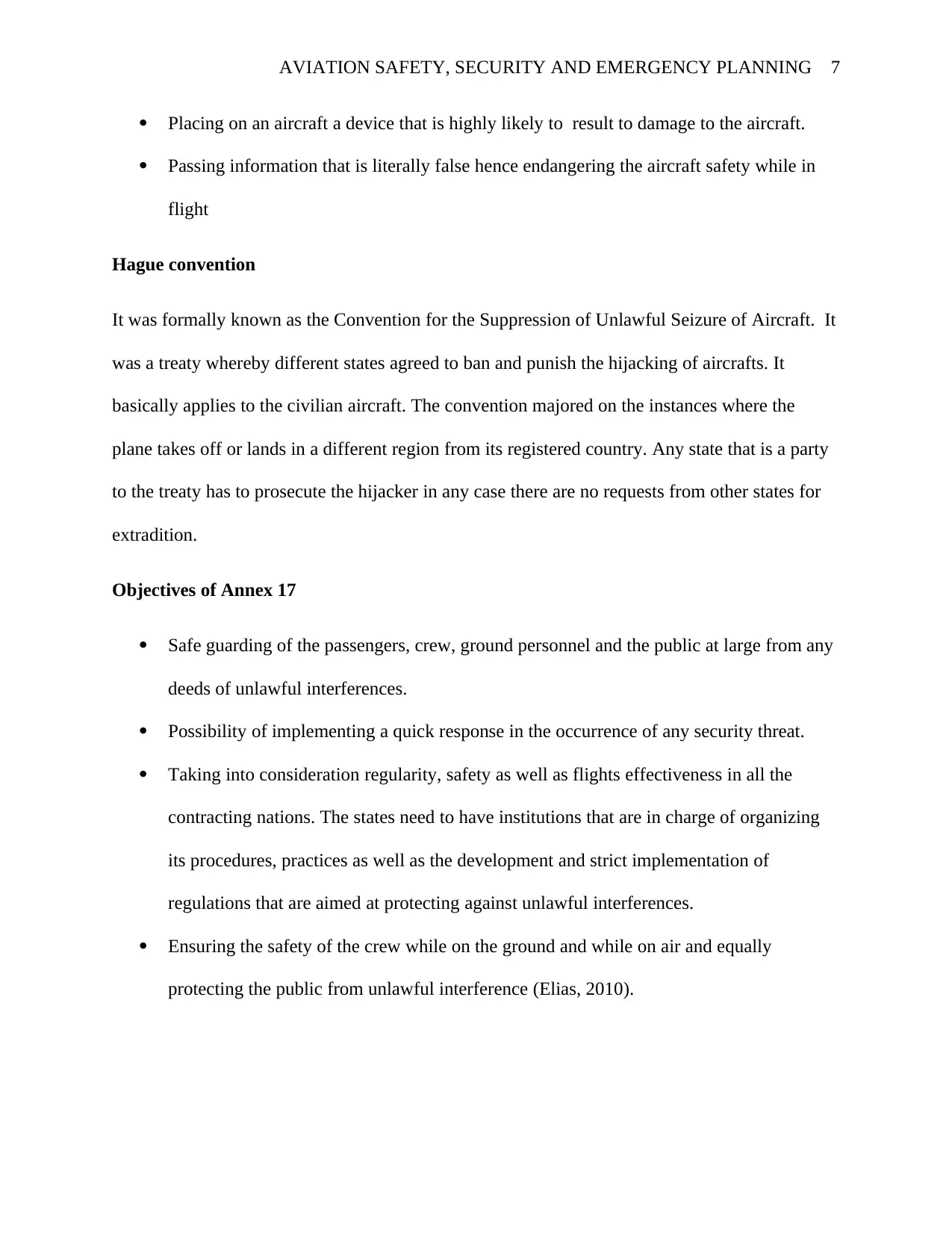
AVIATION SAFETY, SECURITY AND EMERGENCY PLANNING 7
Placing on an aircraft a device that is highly likely to result to damage to the aircraft.
Passing information that is literally false hence endangering the aircraft safety while in
flight
Hague convention
It was formally known as the Convention for the Suppression of Unlawful Seizure of Aircraft. It
was a treaty whereby different states agreed to ban and punish the hijacking of aircrafts. It
basically applies to the civilian aircraft. The convention majored on the instances where the
plane takes off or lands in a different region from its registered country. Any state that is a party
to the treaty has to prosecute the hijacker in any case there are no requests from other states for
extradition.
Objectives of Annex 17
Safe guarding of the passengers, crew, ground personnel and the public at large from any
deeds of unlawful interferences.
Possibility of implementing a quick response in the occurrence of any security threat.
Taking into consideration regularity, safety as well as flights effectiveness in all the
contracting nations. The states need to have institutions that are in charge of organizing
its procedures, practices as well as the development and strict implementation of
regulations that are aimed at protecting against unlawful interferences.
Ensuring the safety of the crew while on the ground and while on air and equally
protecting the public from unlawful interference (Elias, 2010).
Placing on an aircraft a device that is highly likely to result to damage to the aircraft.
Passing information that is literally false hence endangering the aircraft safety while in
flight
Hague convention
It was formally known as the Convention for the Suppression of Unlawful Seizure of Aircraft. It
was a treaty whereby different states agreed to ban and punish the hijacking of aircrafts. It
basically applies to the civilian aircraft. The convention majored on the instances where the
plane takes off or lands in a different region from its registered country. Any state that is a party
to the treaty has to prosecute the hijacker in any case there are no requests from other states for
extradition.
Objectives of Annex 17
Safe guarding of the passengers, crew, ground personnel and the public at large from any
deeds of unlawful interferences.
Possibility of implementing a quick response in the occurrence of any security threat.
Taking into consideration regularity, safety as well as flights effectiveness in all the
contracting nations. The states need to have institutions that are in charge of organizing
its procedures, practices as well as the development and strict implementation of
regulations that are aimed at protecting against unlawful interferences.
Ensuring the safety of the crew while on the ground and while on air and equally
protecting the public from unlawful interference (Elias, 2010).
Paraphrase This Document
Need a fresh take? Get an instant paraphrase of this document with our AI Paraphraser
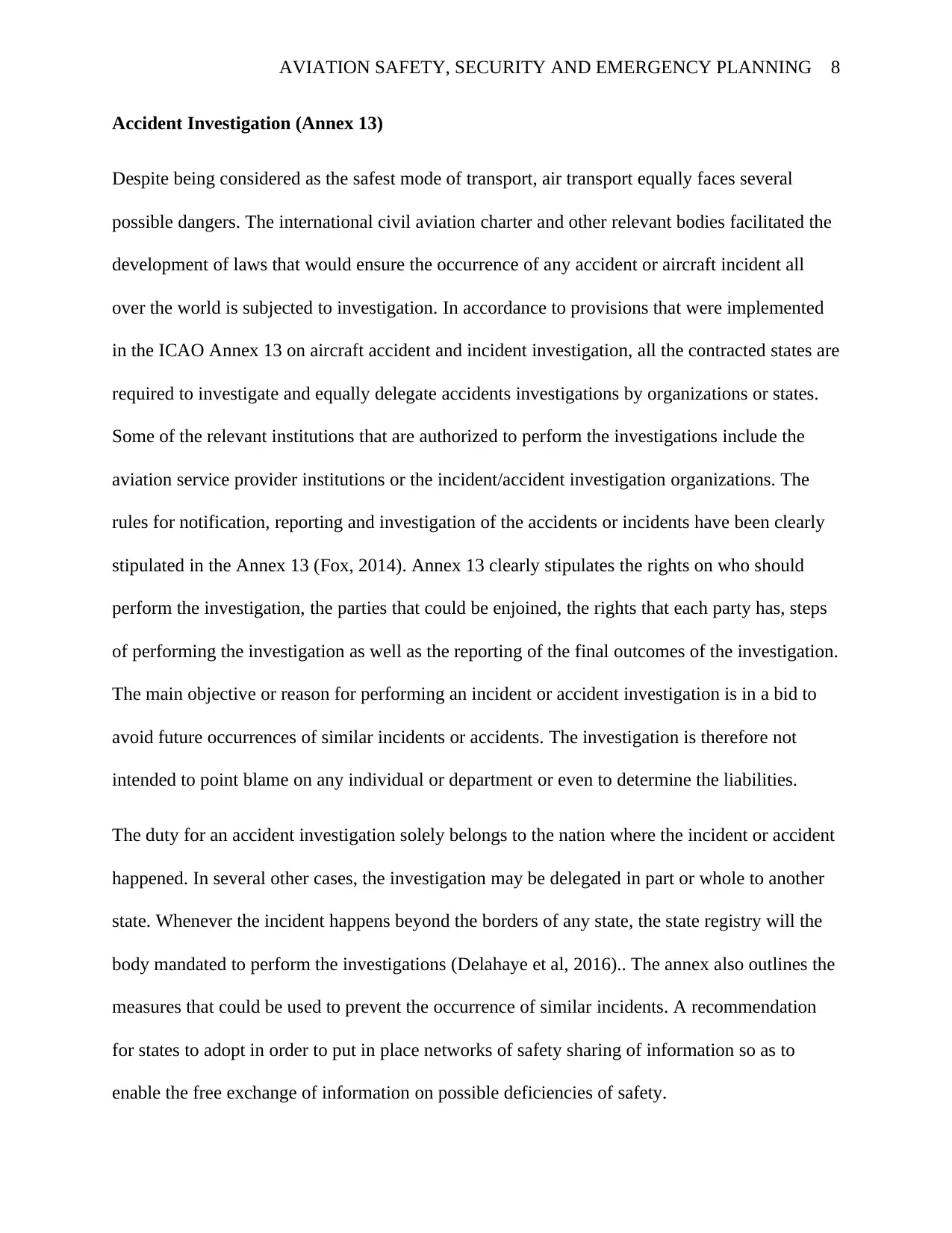
AVIATION SAFETY, SECURITY AND EMERGENCY PLANNING 8
Accident Investigation (Annex 13)
Despite being considered as the safest mode of transport, air transport equally faces several
possible dangers. The international civil aviation charter and other relevant bodies facilitated the
development of laws that would ensure the occurrence of any accident or aircraft incident all
over the world is subjected to investigation. In accordance to provisions that were implemented
in the ICAO Annex 13 on aircraft accident and incident investigation, all the contracted states are
required to investigate and equally delegate accidents investigations by organizations or states.
Some of the relevant institutions that are authorized to perform the investigations include the
aviation service provider institutions or the incident/accident investigation organizations. The
rules for notification, reporting and investigation of the accidents or incidents have been clearly
stipulated in the Annex 13 (Fox, 2014). Annex 13 clearly stipulates the rights on who should
perform the investigation, the parties that could be enjoined, the rights that each party has, steps
of performing the investigation as well as the reporting of the final outcomes of the investigation.
The main objective or reason for performing an incident or accident investigation is in a bid to
avoid future occurrences of similar incidents or accidents. The investigation is therefore not
intended to point blame on any individual or department or even to determine the liabilities.
The duty for an accident investigation solely belongs to the nation where the incident or accident
happened. In several other cases, the investigation may be delegated in part or whole to another
state. Whenever the incident happens beyond the borders of any state, the state registry will the
body mandated to perform the investigations (Delahaye et al, 2016).. The annex also outlines the
measures that could be used to prevent the occurrence of similar incidents. A recommendation
for states to adopt in order to put in place networks of safety sharing of information so as to
enable the free exchange of information on possible deficiencies of safety.
Accident Investigation (Annex 13)
Despite being considered as the safest mode of transport, air transport equally faces several
possible dangers. The international civil aviation charter and other relevant bodies facilitated the
development of laws that would ensure the occurrence of any accident or aircraft incident all
over the world is subjected to investigation. In accordance to provisions that were implemented
in the ICAO Annex 13 on aircraft accident and incident investigation, all the contracted states are
required to investigate and equally delegate accidents investigations by organizations or states.
Some of the relevant institutions that are authorized to perform the investigations include the
aviation service provider institutions or the incident/accident investigation organizations. The
rules for notification, reporting and investigation of the accidents or incidents have been clearly
stipulated in the Annex 13 (Fox, 2014). Annex 13 clearly stipulates the rights on who should
perform the investigation, the parties that could be enjoined, the rights that each party has, steps
of performing the investigation as well as the reporting of the final outcomes of the investigation.
The main objective or reason for performing an incident or accident investigation is in a bid to
avoid future occurrences of similar incidents or accidents. The investigation is therefore not
intended to point blame on any individual or department or even to determine the liabilities.
The duty for an accident investigation solely belongs to the nation where the incident or accident
happened. In several other cases, the investigation may be delegated in part or whole to another
state. Whenever the incident happens beyond the borders of any state, the state registry will the
body mandated to perform the investigations (Delahaye et al, 2016).. The annex also outlines the
measures that could be used to prevent the occurrence of similar incidents. A recommendation
for states to adopt in order to put in place networks of safety sharing of information so as to
enable the free exchange of information on possible deficiencies of safety.
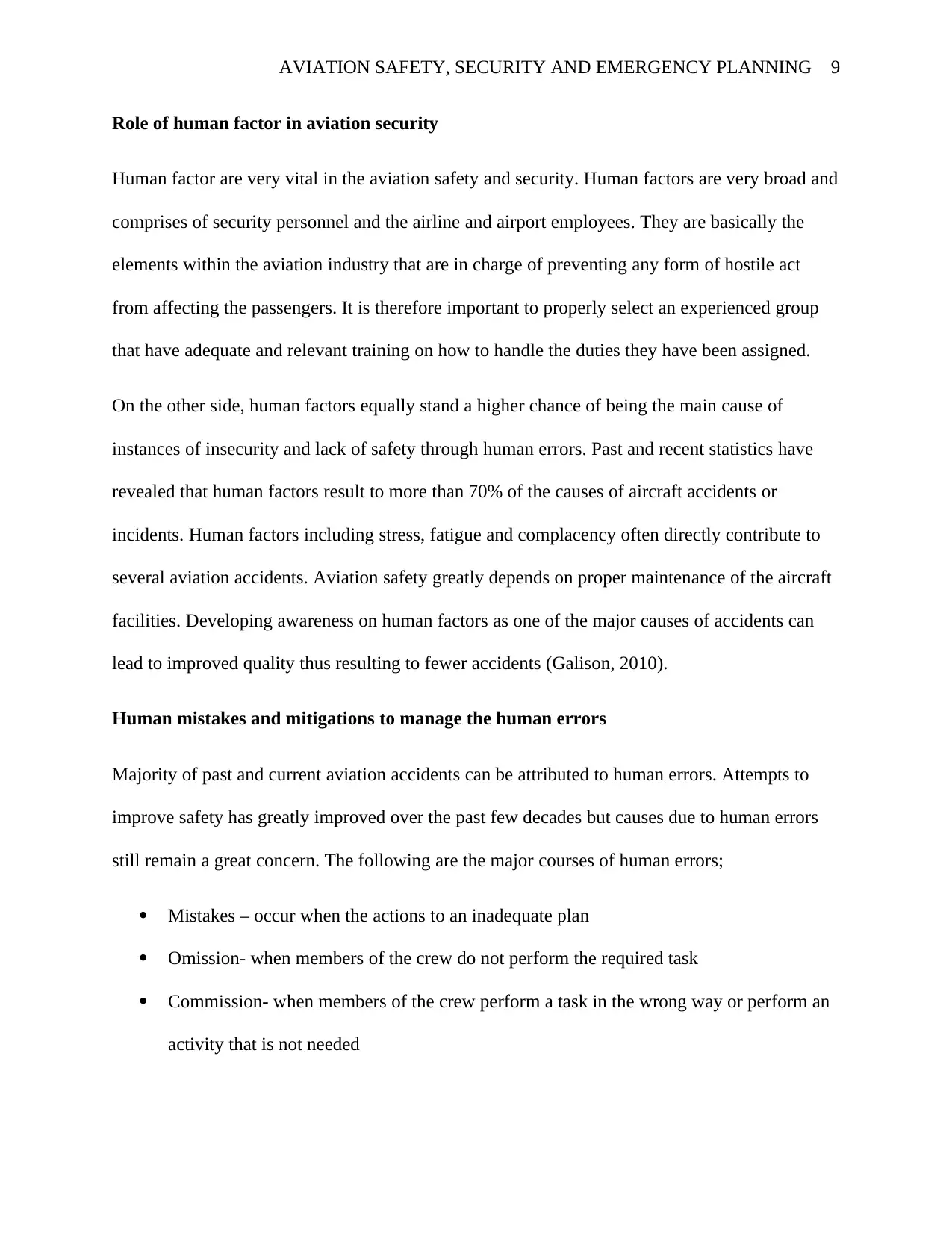
AVIATION SAFETY, SECURITY AND EMERGENCY PLANNING 9
Role of human factor in aviation security
Human factor are very vital in the aviation safety and security. Human factors are very broad and
comprises of security personnel and the airline and airport employees. They are basically the
elements within the aviation industry that are in charge of preventing any form of hostile act
from affecting the passengers. It is therefore important to properly select an experienced group
that have adequate and relevant training on how to handle the duties they have been assigned.
On the other side, human factors equally stand a higher chance of being the main cause of
instances of insecurity and lack of safety through human errors. Past and recent statistics have
revealed that human factors result to more than 70% of the causes of aircraft accidents or
incidents. Human factors including stress, fatigue and complacency often directly contribute to
several aviation accidents. Aviation safety greatly depends on proper maintenance of the aircraft
facilities. Developing awareness on human factors as one of the major causes of accidents can
lead to improved quality thus resulting to fewer accidents (Galison, 2010).
Human mistakes and mitigations to manage the human errors
Majority of past and current aviation accidents can be attributed to human errors. Attempts to
improve safety has greatly improved over the past few decades but causes due to human errors
still remain a great concern. The following are the major courses of human errors;
Mistakes – occur when the actions to an inadequate plan
Omission- when members of the crew do not perform the required task
Commission- when members of the crew perform a task in the wrong way or perform an
activity that is not needed
Role of human factor in aviation security
Human factor are very vital in the aviation safety and security. Human factors are very broad and
comprises of security personnel and the airline and airport employees. They are basically the
elements within the aviation industry that are in charge of preventing any form of hostile act
from affecting the passengers. It is therefore important to properly select an experienced group
that have adequate and relevant training on how to handle the duties they have been assigned.
On the other side, human factors equally stand a higher chance of being the main cause of
instances of insecurity and lack of safety through human errors. Past and recent statistics have
revealed that human factors result to more than 70% of the causes of aircraft accidents or
incidents. Human factors including stress, fatigue and complacency often directly contribute to
several aviation accidents. Aviation safety greatly depends on proper maintenance of the aircraft
facilities. Developing awareness on human factors as one of the major causes of accidents can
lead to improved quality thus resulting to fewer accidents (Galison, 2010).
Human mistakes and mitigations to manage the human errors
Majority of past and current aviation accidents can be attributed to human errors. Attempts to
improve safety has greatly improved over the past few decades but causes due to human errors
still remain a great concern. The following are the major courses of human errors;
Mistakes – occur when the actions to an inadequate plan
Omission- when members of the crew do not perform the required task
Commission- when members of the crew perform a task in the wrong way or perform an
activity that is not needed
⊘ This is a preview!⊘
Do you want full access?
Subscribe today to unlock all pages.

Trusted by 1+ million students worldwide
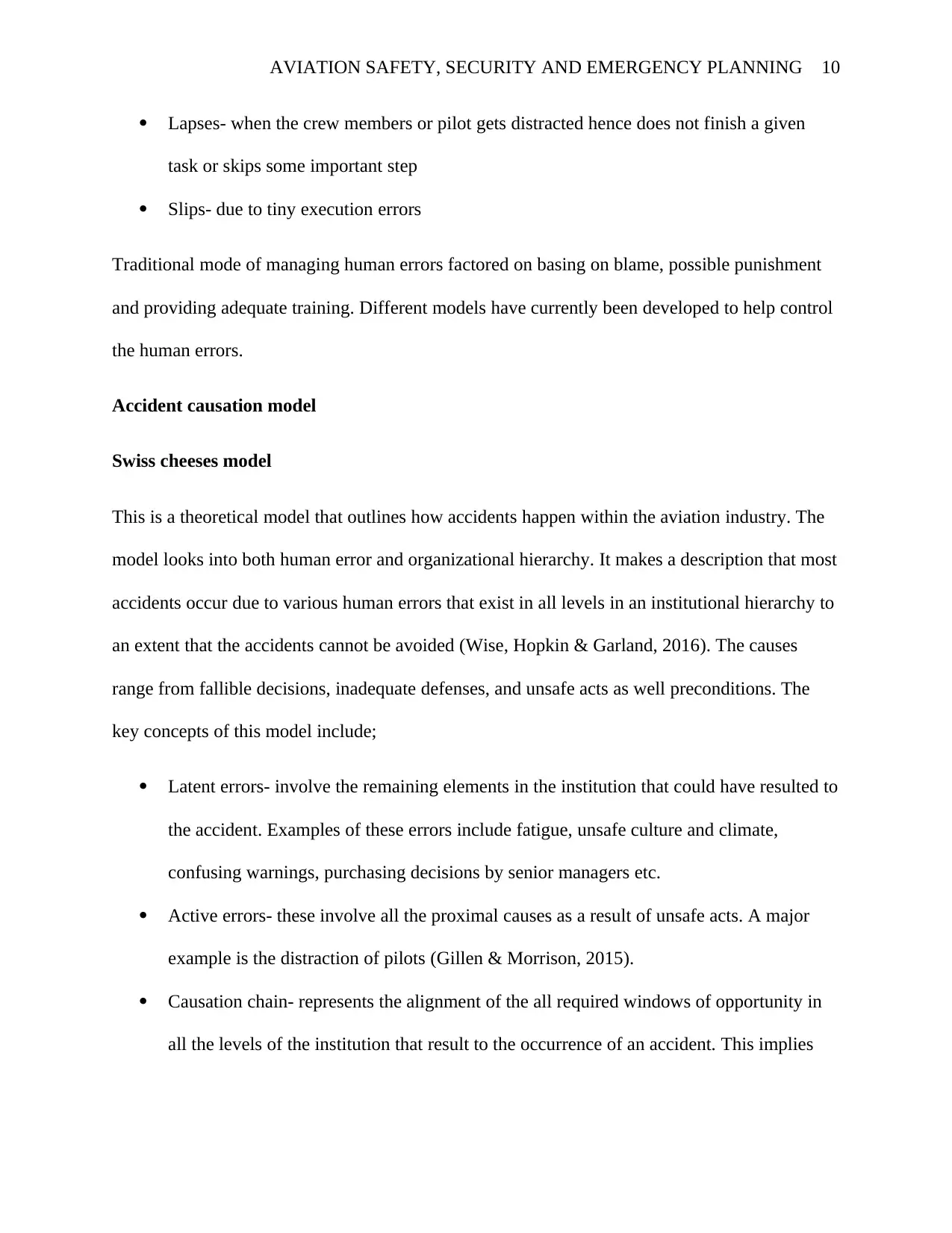
AVIATION SAFETY, SECURITY AND EMERGENCY PLANNING 10
Lapses- when the crew members or pilot gets distracted hence does not finish a given
task or skips some important step
Slips- due to tiny execution errors
Traditional mode of managing human errors factored on basing on blame, possible punishment
and providing adequate training. Different models have currently been developed to help control
the human errors.
Accident causation model
Swiss cheeses model
This is a theoretical model that outlines how accidents happen within the aviation industry. The
model looks into both human error and organizational hierarchy. It makes a description that most
accidents occur due to various human errors that exist in all levels in an institutional hierarchy to
an extent that the accidents cannot be avoided (Wise, Hopkin & Garland, 2016). The causes
range from fallible decisions, inadequate defenses, and unsafe acts as well preconditions. The
key concepts of this model include;
Latent errors- involve the remaining elements in the institution that could have resulted to
the accident. Examples of these errors include fatigue, unsafe culture and climate,
confusing warnings, purchasing decisions by senior managers etc.
Active errors- these involve all the proximal causes as a result of unsafe acts. A major
example is the distraction of pilots (Gillen & Morrison, 2015).
Causation chain- represents the alignment of the all required windows of opportunity in
all the levels of the institution that result to the occurrence of an accident. This implies
Lapses- when the crew members or pilot gets distracted hence does not finish a given
task or skips some important step
Slips- due to tiny execution errors
Traditional mode of managing human errors factored on basing on blame, possible punishment
and providing adequate training. Different models have currently been developed to help control
the human errors.
Accident causation model
Swiss cheeses model
This is a theoretical model that outlines how accidents happen within the aviation industry. The
model looks into both human error and organizational hierarchy. It makes a description that most
accidents occur due to various human errors that exist in all levels in an institutional hierarchy to
an extent that the accidents cannot be avoided (Wise, Hopkin & Garland, 2016). The causes
range from fallible decisions, inadequate defenses, and unsafe acts as well preconditions. The
key concepts of this model include;
Latent errors- involve the remaining elements in the institution that could have resulted to
the accident. Examples of these errors include fatigue, unsafe culture and climate,
confusing warnings, purchasing decisions by senior managers etc.
Active errors- these involve all the proximal causes as a result of unsafe acts. A major
example is the distraction of pilots (Gillen & Morrison, 2015).
Causation chain- represents the alignment of the all required windows of opportunity in
all the levels of the institution that result to the occurrence of an accident. This implies
Paraphrase This Document
Need a fresh take? Get an instant paraphrase of this document with our AI Paraphraser
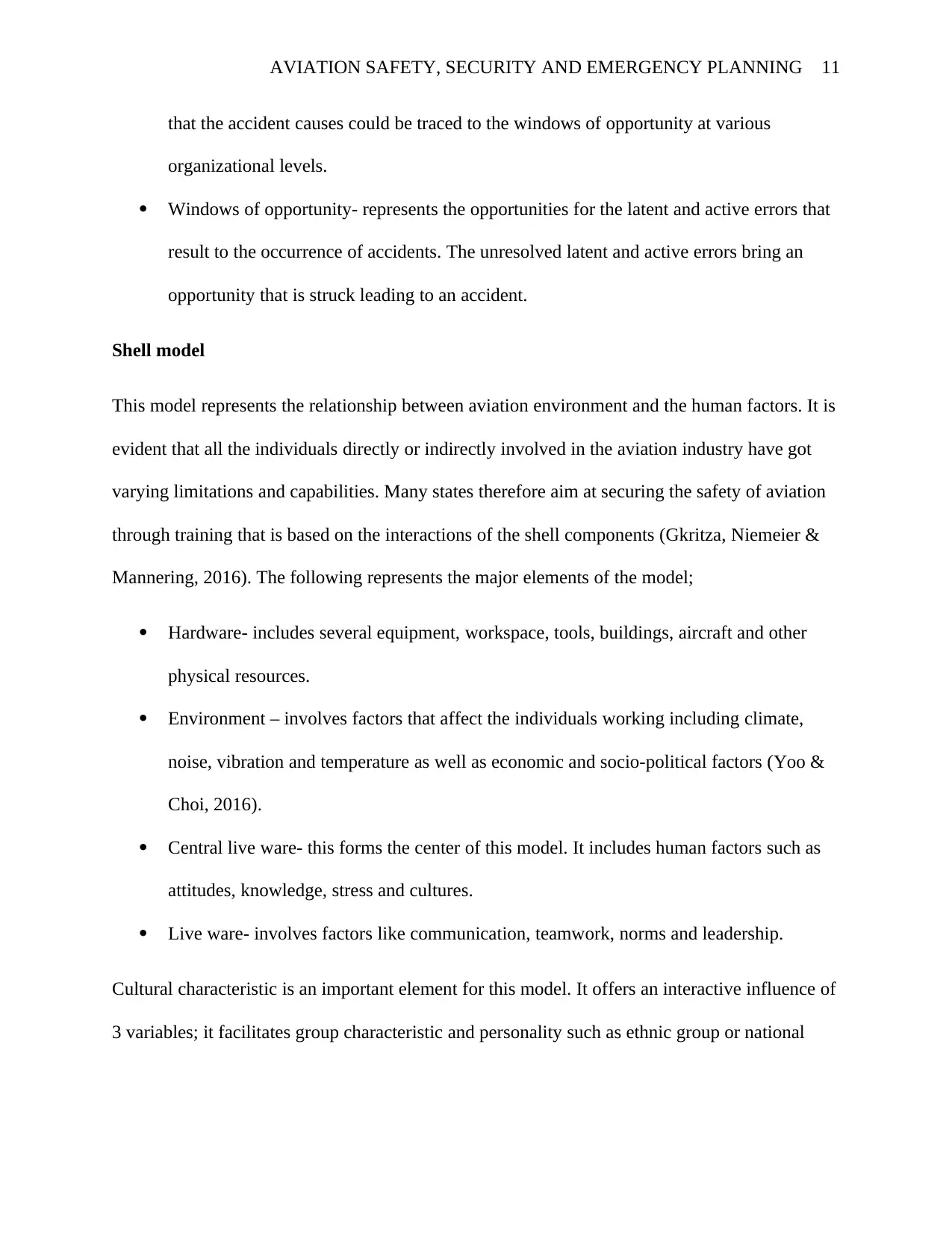
AVIATION SAFETY, SECURITY AND EMERGENCY PLANNING 11
that the accident causes could be traced to the windows of opportunity at various
organizational levels.
Windows of opportunity- represents the opportunities for the latent and active errors that
result to the occurrence of accidents. The unresolved latent and active errors bring an
opportunity that is struck leading to an accident.
Shell model
This model represents the relationship between aviation environment and the human factors. It is
evident that all the individuals directly or indirectly involved in the aviation industry have got
varying limitations and capabilities. Many states therefore aim at securing the safety of aviation
through training that is based on the interactions of the shell components (Gkritza, Niemeier &
Mannering, 2016). The following represents the major elements of the model;
Hardware- includes several equipment, workspace, tools, buildings, aircraft and other
physical resources.
Environment – involves factors that affect the individuals working including climate,
noise, vibration and temperature as well as economic and socio-political factors (Yoo &
Choi, 2016).
Central live ware- this forms the center of this model. It includes human factors such as
attitudes, knowledge, stress and cultures.
Live ware- involves factors like communication, teamwork, norms and leadership.
Cultural characteristic is an important element for this model. It offers an interactive influence of
3 variables; it facilitates group characteristic and personality such as ethnic group or national
that the accident causes could be traced to the windows of opportunity at various
organizational levels.
Windows of opportunity- represents the opportunities for the latent and active errors that
result to the occurrence of accidents. The unresolved latent and active errors bring an
opportunity that is struck leading to an accident.
Shell model
This model represents the relationship between aviation environment and the human factors. It is
evident that all the individuals directly or indirectly involved in the aviation industry have got
varying limitations and capabilities. Many states therefore aim at securing the safety of aviation
through training that is based on the interactions of the shell components (Gkritza, Niemeier &
Mannering, 2016). The following represents the major elements of the model;
Hardware- includes several equipment, workspace, tools, buildings, aircraft and other
physical resources.
Environment – involves factors that affect the individuals working including climate,
noise, vibration and temperature as well as economic and socio-political factors (Yoo &
Choi, 2016).
Central live ware- this forms the center of this model. It includes human factors such as
attitudes, knowledge, stress and cultures.
Live ware- involves factors like communication, teamwork, norms and leadership.
Cultural characteristic is an important element for this model. It offers an interactive influence of
3 variables; it facilitates group characteristic and personality such as ethnic group or national
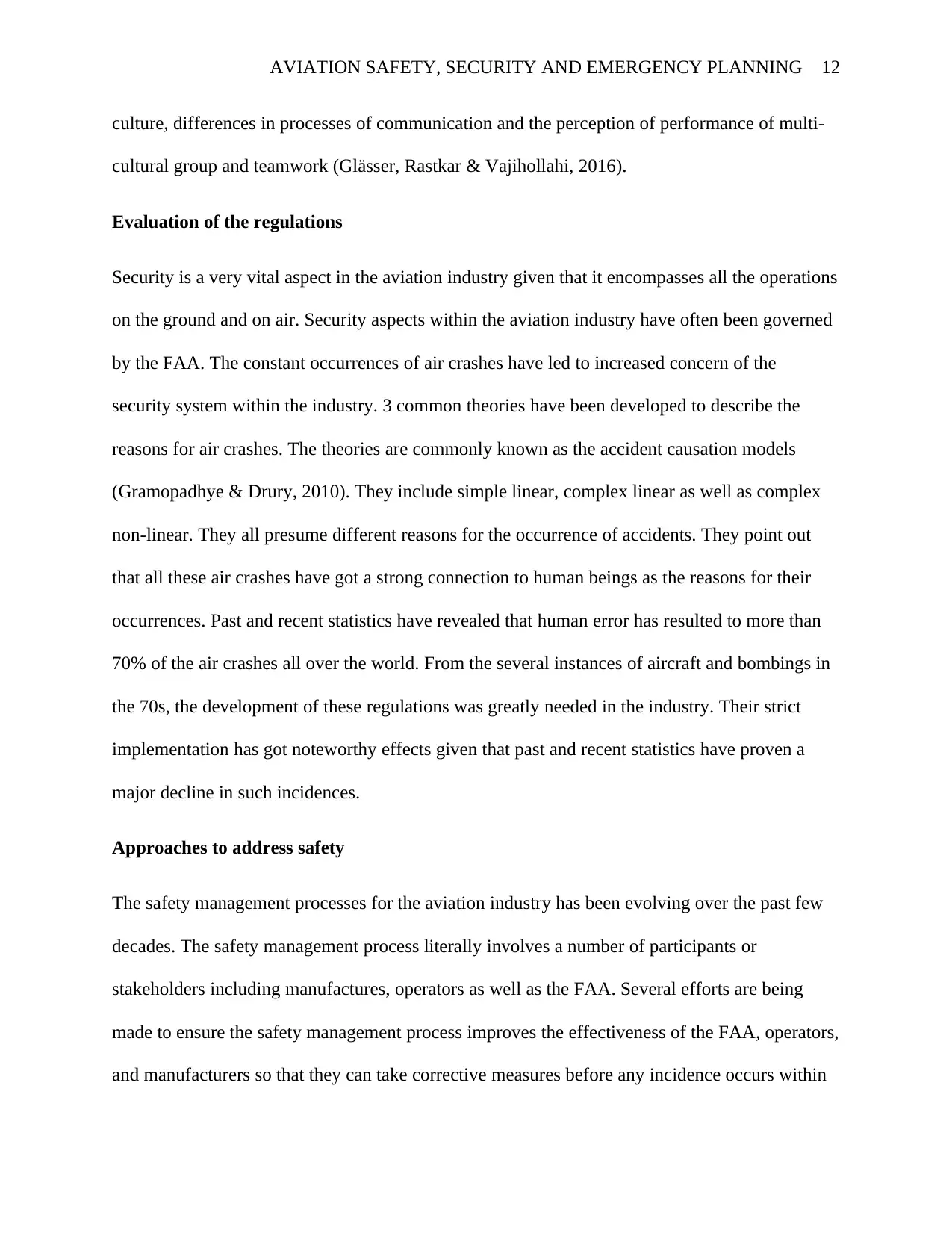
AVIATION SAFETY, SECURITY AND EMERGENCY PLANNING 12
culture, differences in processes of communication and the perception of performance of multi-
cultural group and teamwork (Glässer, Rastkar & Vajihollahi, 2016).
Evaluation of the regulations
Security is a very vital aspect in the aviation industry given that it encompasses all the operations
on the ground and on air. Security aspects within the aviation industry have often been governed
by the FAA. The constant occurrences of air crashes have led to increased concern of the
security system within the industry. 3 common theories have been developed to describe the
reasons for air crashes. The theories are commonly known as the accident causation models
(Gramopadhye & Drury, 2010). They include simple linear, complex linear as well as complex
non-linear. They all presume different reasons for the occurrence of accidents. They point out
that all these air crashes have got a strong connection to human beings as the reasons for their
occurrences. Past and recent statistics have revealed that human error has resulted to more than
70% of the air crashes all over the world. From the several instances of aircraft and bombings in
the 70s, the development of these regulations was greatly needed in the industry. Their strict
implementation has got noteworthy effects given that past and recent statistics have proven a
major decline in such incidences.
Approaches to address safety
The safety management processes for the aviation industry has been evolving over the past few
decades. The safety management process literally involves a number of participants or
stakeholders including manufactures, operators as well as the FAA. Several efforts are being
made to ensure the safety management process improves the effectiveness of the FAA, operators,
and manufacturers so that they can take corrective measures before any incidence occurs within
culture, differences in processes of communication and the perception of performance of multi-
cultural group and teamwork (Glässer, Rastkar & Vajihollahi, 2016).
Evaluation of the regulations
Security is a very vital aspect in the aviation industry given that it encompasses all the operations
on the ground and on air. Security aspects within the aviation industry have often been governed
by the FAA. The constant occurrences of air crashes have led to increased concern of the
security system within the industry. 3 common theories have been developed to describe the
reasons for air crashes. The theories are commonly known as the accident causation models
(Gramopadhye & Drury, 2010). They include simple linear, complex linear as well as complex
non-linear. They all presume different reasons for the occurrence of accidents. They point out
that all these air crashes have got a strong connection to human beings as the reasons for their
occurrences. Past and recent statistics have revealed that human error has resulted to more than
70% of the air crashes all over the world. From the several instances of aircraft and bombings in
the 70s, the development of these regulations was greatly needed in the industry. Their strict
implementation has got noteworthy effects given that past and recent statistics have proven a
major decline in such incidences.
Approaches to address safety
The safety management processes for the aviation industry has been evolving over the past few
decades. The safety management process literally involves a number of participants or
stakeholders including manufactures, operators as well as the FAA. Several efforts are being
made to ensure the safety management process improves the effectiveness of the FAA, operators,
and manufacturers so that they can take corrective measures before any incidence occurs within
⊘ This is a preview!⊘
Do you want full access?
Subscribe today to unlock all pages.

Trusted by 1+ million students worldwide
1 out of 42
Related Documents
Your All-in-One AI-Powered Toolkit for Academic Success.
+13062052269
info@desklib.com
Available 24*7 on WhatsApp / Email
![[object Object]](/_next/static/media/star-bottom.7253800d.svg)
Unlock your academic potential
Copyright © 2020–2025 A2Z Services. All Rights Reserved. Developed and managed by ZUCOL.




